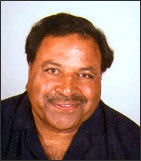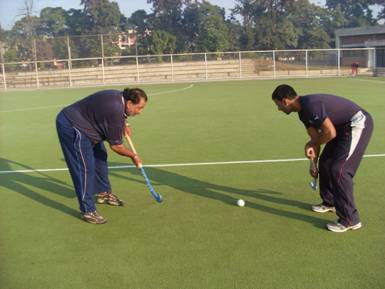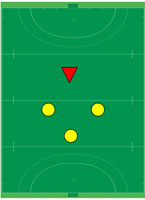Mini Hockey Coaching
For Young Athletes

For more coaching information, visit www.coachshiv.com
| January | February | March |
|
April | May | June |
|  |
|||||
| July | August | September | October | November | December | |
![]()
INTRODUCTION
This article provides mini hockey coaching tactics, with the larger objective of developing the game sense of a young athlete. Every pass, move or lead made, has a direct or indirect effect on the main objective and outcome of the play.
On the surface, a pass made may sometimes look unnecessary unimportant, especially when building an attack. However, when we correlate the small picture with the big picture, one can see its importance and its effect on the final outcome. It is vital that we coaches educate our young athletes to understand these concepts clearly, using the medium of mini hockey, as these strong fundamentals are what separate a good player from a great one!
WHERE TO START?
Work on the technique of passing and receiving, starting with a semi-static situation, followed by doing it on the run (see the two photographs below).
| Passing and receiving the ball in a semi-static situation | Passing and receiving the ball on the run |
 |
 |
While passing and receiving on the run, it is strongly recommended that the players simulate their field positions, e.g., centre-half, right-in, left-in, etc.
Additionally, while the players are passing/receiving on the run, it is important that they understand the field-specific passing/receiving techniques. In other words, how will they receive a pass on a open stick (pass from centre-half to right-in) and a reverse stick (pass from centre-half to left-in). Later on, combine these three players to form a triangle and pass the ball, as would have been passed by the midfield triangle.
MINI HOCKEY COACHING TIPS
| Building upon the Midfield Triangle |
Centre-half passes the ball to the left-in, gets it back, then passes to the right-in, gets it back, passes to the left-in, and the sequence keeps repeating.
This can be practiced up and down a field length of 50 meters. Later, one can add right-out and left-outs, maybe even the centre-forward, to add more triangles to the equation.
| Path of the Ball |
What skills to focus upon while receiving the ball on the run, merits a separate article in itself. For now, we will just focus upon the tactical aspects - where to pass and why. For instance, when the ball comes from the left, pass it to the right, and vice versa.. The key here is for young players to be aware of the path of the ball.
| Game Fundamentals |
There are two fundamentals to impart to the young players during these mini hockey sessions:
First-time Play: Enforce 3-5 touches for beginners and 1-2 touches for experienced players
Change of Focus: When the ball comes from the left, pass it to the right, and vice versa, thereby using the width of the field
| Role & Responsibility |
Players must be aware of, and perform the Role and Responsibility (R&R) of the position they are in. If a player changes his position, he should switch his R&R thinking to the new position and zone of the field. For example, when the right-in switches to a right-out, he should adopt the R&R of a right-out, and note be playing as a right-in.
Also, R&R remains constant, whether one is playing on the whole field or in a shrunken playing area. If they adopt such a mind set, players will be able to smoothly translate their game from mini to regular hockey.
At the highest level, Shabaz Ahmed was one forward who could switch his position, and simultaneously switch his mental gears and adjust his technical/tactical skills accordingly. This is one of the hardest things to coach and employ. With all due respect, I have not seen top European or Australian players use this concept to the same degree of clarity and success as Shabaz Ahmed of Pakistan.
| Freeze Frame |
A coach should often times freeze the game and explain to the players their changing roles, where they are doing good, and what areas need improvement. A coach should provide instant feedback, even to the smallest details, to the players, as immediate feedback has better retention in the player than feedback given much later.
| Mini Hockey Field Sizes |
Design the mini hockey fields according to the number of players, their skill level and the objective of the mini game. Following are some guidelines.
2-on-1: 10 x 7 metres
3-on-1: 15 x 10 metres
5-on-2: 30 x 25 metres
3-ON-1 MINI HOCKEY EXAMPLE
The concept of mini hockey is elaborated through the 3-on-1 use-case scenario below:
| Step 1 | Step 2 | |
 |
Step 1 (left) - Centre-half, right-in and left-in are in their respective positions (in yellow) vs. 1 defender (in red)
Step 2 (right) - Centre-half passes the ball to the right-in, and gets it back. Now he passes ball to the left-in. |
 |
| Step 3 | ||
| Step 3 (right) - Note how the right-in and left-in have floated wide to use the width of the field. This makes it harder for the opposing defender to simultaneously cover them both. |  |
This forces the defender to make a decision and go towards one forward. To which of the forwards will he go to? |
| Step 4 | Step 5 | |
 |
Step 4 (left) - In this situation, the defender goes to the left-in, who makes a return pass to centre-half, who makes a quick first-time pass to the leading right-in. Step 5 (right) - After give-and-go between the right-in and centre-half, right-in enters the circle and takes shot at goal. |
 |
A similar scenario for 5-on-2 mini-hockey will be demonstrated in a later article.
CONCLUSION

German football coach Hennes Weisweiler
I would like to conclude this article with the following quote from German football coach Hennes Weisweiler, who unearthed the talent of, among others, World Cup winning footballer Berti Vogts:
"In the beginning of a training session, I like to start with a practice of 5 on 2. This is designed to improve teamwork (since it is 5 vs. only 2), but also to bring a good spirit to the training.
In these 5 on 2 sessions, we start with the two touches per player, and later switch to one touch per player. I saw this 5 on 2 practice played by Brazil during the 1970 World Cup in Mexico and we used to call it 'Ole'."
As a take-away from this article, think of the various Brazilian football players and their victorious teams. The Brazilians are masters of forming mini teams during the run of play, creating numerical advantage and dominating the play, taking one mini step at a time. No wonder the Brazilian style has immensely influenced the world of football, either directly and indirectly, so much so that everyone wants to play the 'Brazilian Way'.
![]()